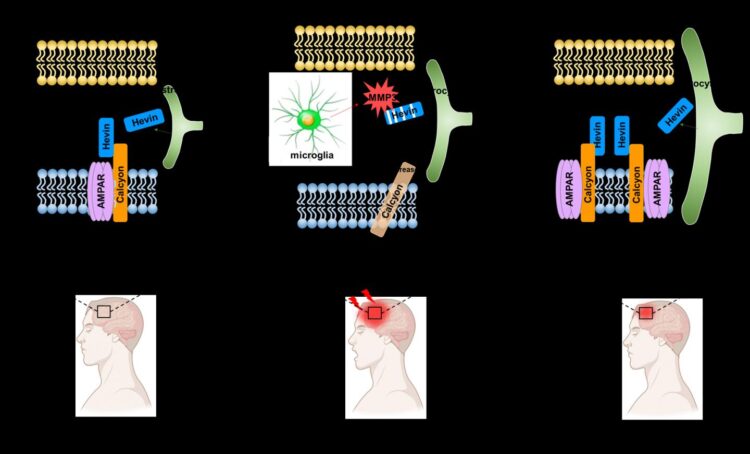Neuroinflammatory response-induced proteases impede the recovery process from brain injury; novel interactions between proteins (hevin and calcyon) help in the recovery of neurons in a mature brain
Patients with brain injury (caused by stroke or trauma) primarily rely on rehabilitation therapy for recovery, as there are no other known effective treatment methods. The rate of recovery from brain injury observed in adults is significantly slower (or the recovery is impossible) than that observed in young children. The consensus among researchers is that the number of excess neural stem cells capable of restoring brain functions is lower in a mature brain than that in the brain of young children.
A Korean research team reported a novel mechanism to describe the brain injury recovery process. The researchers reported that when the animal model experiment was conducted, the time taken to recover from a brain injury could be controlled by regulating the proteins. The Korea Institute of Science and Technology (KIST) has released an announcement that a team led by Dr. Eun Mi Hwang of the Brain Science Institute, KIST collaborated with another team led by Prof. Kyoungho Suk of the School of Medicine, Kyungpook National University and reported the presence of a novel interaction between proteins (hevin-calcyon); this interaction plays a critical role in the brain injury recovery process in adults. The researchers also revealed that this interaction plays an important role in the early stages of recovery.
The researchers working at KIST identified the calcyon protein as a novel interaction partner of hevin, a protein secreted by the glial cells present in the brain. They also reported that the interaction between the proteins played a critical role in the recovery process of neuronal cells present in an injured adult brain. As neurons are cells that directly influence brain activity, it is believed that brain diseases can be cured when they are recovered and/or treated.
*Glial cells : Cells that support the tissues of the central nervous system, provide nutrients to neurons inside the brain and spinal cord, and create a chemical environment suitable for the activities of neurons
The results from the experiments revealed that an increase in the number of hevin-calcyon interactions in the brain could promote synaptic contacts and reorganization, which could help in the early recovery of the impaired brain. The hevin-calcyon interaction and the expression of these proteins were confirmed by studying healthy brain tissues. It was also observed that the number of interactions in patients suffering from the condition of traumatic brain injury was significantly reduced.
Researchers at the Kyungpook National University studied the recovery process of brain injury by studying the hevin and calcyon interaction using a brain injury animal model. They reported that the neuroinflammatory response-induced proteases formed in the early stages of brain injury resulted in the fragmentation of hevin. This also impeded the generation of the hevin and calcyon interaction. Experiments were conducted using an animal model of brain injury. It was observed that the recovery time could be reduced to approximately 2 to 3 weeks (from 4 weeks) if an inflammatory response inhibitor was administered directly to the injured region of the brain. The rate of recovery could be further slowed by administering an additional inflammatory protein.
The joint research team reported that the absence of the hevin-calcyon interaction in the early stages (a critical period in the recovery process of brain injury) of the recovery process might negatively impact the effective recovery process. The reported result is the outcome of the five years of persistent efforts by the team led by Dr. Eun Mi Hwang of KIST (this team identified the novel interaction between proteins), team led by Dr. Hoon Ryu of KIST (this team investigated human traumatic brain injury), and team led by Prof. Kyoungho Suk of the Kyungpook National University (this team studied the properties of inflammation using various animal models). Each team contributed to the findings based on their area of expertise.
Dr. Eun Mi Hwang of KIST said, “The hevin-calcyon interaction can potentially help in treating brain diseases as brain injury and neurodegenerative diseases can result in the generation of inflammatory responses.” She also added, “The findings can potentially help in the development of procedures for treating refractory brain diseases caused by impaired synaptogenic activity.”
###
This research was conducted as a part of the Core Technology Development Project in Neuroscience funded by the National Research Foundation of Korea and supported by the Ministry of Science and ICT (MSIT). The results were published in the latest issue of “Cell Death & Differentiation” (IF: 10.717, top 6.229% in JCR), an international academic journal.
Media Contact
Do-Hyun Kim
[email protected]
Related Journal Article
http://dx.





